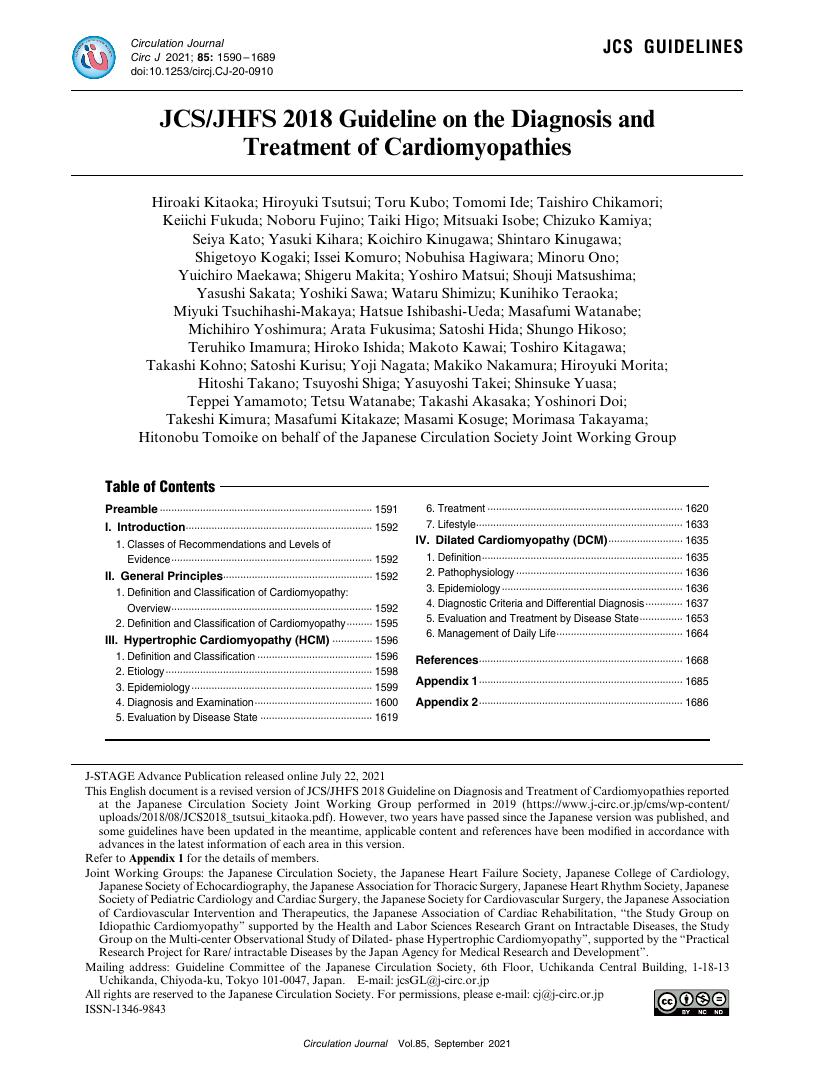- J-STAGE home
- /
- Circulation Journal
- /
- Volume 85 (2021) Issue 9
- /
- Article overview
-
Hiroaki Kitaoka
Department of Cardiology and Geriatrics, Kochi Medical School, Kochi University [Japan]
-
Hiroyuki Tsutsui
Department of Cardiovascular Medicine, Kyushu University [Japan]
-
Toru Kubo
Department of Cardiology and Geriatrics, Kochi Medical School, Kochi University [Japan]
-
Tomomi Ide
Department of Cardiovascular Medicine, Kyushu University [Japan]
-
Taishiro Chikamori
Department of Cardiology, Tokyo Medical University Hospital [Japan]
-
Keiichi Fukuda
Department of Cardiology, Keio University School of Medicine [Japan]
-
Noboru Fujino
Department of Cardiovascular and Internal Medicine, Kanazawa University, Graduate School of Medical Science [Japan]
-
Taiki Higo
Department of Cardiovascular Medicine, Kyushu University Graduate School of Medical Sciences [Japan]
-
Mitsuaki Isobe
Sakakibara Heart Institute [Japan]
-
Chizuko Kamiya
Department of Perinatology and Gynecology, National Cerebral and Cardiovascular Center [Japan]
-
Seiya Kato
Division of Pathology, Saiseikai Fukuoka General Hospital [Japan]
-
Yasuki Kihara
Kobe City Medical Center General Hospital [Japan]
-
Koichiro Kinugawa
Second Department of Internal Medicine, University of Toyama [Japan]
-
Shintaro Kinugawa
Department of Cardiovascular Medicine, Kyushu University [Japan]
-
Shigetoyo Kogaki
Department of Pediatrics and Neonatology, Osaka General Medical Center [Japan]
-
Issei Komuro
Department of Cardiovascular Medicine, Graduate School of Medicine, The University of Tokyo [Japan]
-
Nobuhisa Hagiwara
Department of Cardiology, Tokyo Women’s Medical University [Japan]
-
Minoru Ono
Department of Cardiac Surgery, The University of Tokyo Hospital [Japan]
-
Yuichiro Maekawa
Division of Cardiology, Internal Medicine III, Hamamatsu University School of Medicine [Japan]
-
Shigeru Makita
Department of Cardiac Rehabilitation, Saitama International Medical Center, Saitama Medical University [Japan]
-
Yoshiro Matsui
Department of Cardiac Surgery, Hanaoka Seishu Memorial Hospital [Japan]
-
Shouji Matsushima
Department of Cardiovascular Medicine, Kyushu University [Japan]
-
Yasushi Sakata
Department of Cardiovascular Medicine, Osaka University Graduate School of Medicine [Japan]
-
Yoshiki Sawa
Department of Cardiovascular Surgery, Osaka University Graduate School of Medicine [Japan]
-
Wataru Shimizu
Department of Cardiovascular Medicine, Nippon Medical School [Japan]
-
Kunihiko Teraoka
Department of Cardiology, Sakakibara Heart Institute [Japan]
-
Miyuki Tsuchihashi-Makaya
School of Nursing, Kitasato University [Japan]
-
Hatsue Ishibashi-Ueda
Department of Pathology, National Cerebral and Cardiovascular Center [Japan]
-
Masafumi Watanabe
Department of Cardiology, Pulmonology, and Nephrology, Yamagata University Faculty of Medicine [Japan]
-
Michihiro Yoshimura
Division of Cardiology, Department of Internal Medicine, The Jikei University School of Medicine [Japan]
-
Arata Fukusima
Asabu Heart & Gastrointestinal Clinic [Japan]
-
Satoshi Hida
Department of Cardiovascular Medicine, Tokyo Medical University [Japan]
-
Shungo Hikoso
Department of Cardiovascular Medicine, Osaka University Graduate School of Medicine [Japan]
-
Teruhiko Imamura
Second Department of Internal Medicine, University of Toyama [Japan]
-
Hiroko Ishida
Nippon Medical School, Musashikosugi Hospital [Japan]
-
Makoto Kawai
Division of Cardiology, Department of Internal Medicine, The Jikei University School of Medicine [Japan]
-
Toshiro Kitagawa
Department of Cardiovascular Medicine, Hiroshima University Graduate School of Biomedical and Health Sciences [Japan]
-
Takashi Kohno
Department of Cardiovascular Medicine, Kyorin University School of Medicine [Japan]
-
Satoshi Kurisu
Department of Cardiovascular Medicine, Hiroshima University Graduate School of Biomedical and Health Sciences [Japan]
-
Yoji Nagata
Division of Cardiology, Fukui CardioVascular Center [Japan]
-
Makiko Nakamura
Second Department of Internal Medicine, University of Toyama [Japan]
-
Hiroyuki Morita
Department of Cardiovascular Medicine, Graduate School of Medicine, The University of Tokyo [Japan]
-
Hitoshi Takano
Department of Cardiovascular Medicine, Nippon Medical School Hospital [Japan]
-
Tsuyoshi Shiga
Department of Clinical Pharmacology and Therapeutics, The Jikei University School of Medicine [Japan]
-
Yasuyoshi Takei
Department of Cardiology, Tokyo Medical University Hospital [Japan]
-
Shinsuke Yuasa
Department of Cardiology, Keio University School of Medicine [Japan]
-
Teppei Yamamoto
Department of Cardiovascular Medicine, Nippon Medical School [Japan]
-
Tetsu Watanabe
Department of Cardiology, Pulmonology, and Nephrology, Yamagata University Faculty of Medicine [Japan]
-
Takashi Akasaka
Department of Cardiovascular Medicine, Wakayama Medical University [Japan]
-
Yoshinori Doi
Department of Medicine, Chikamori Hospital [Japan]
-
Takeshi Kimura
Department of Cardiovascular Medicine, Kyoto University Graduate School of Medicine [Japan]
-
Masafumi Kitakaze
Department of Cardiology, Hanwa Daini Senboku Hospital [Japan]
-
Masami Kosuge
Division of Cardiology, Yokohama City University Medical Center [Japan]
-
Morimasa Takayama
Department of Cardiology, Sakakibara Heart Institute [Japan]
-
Hitonobu Tomoike
Sakakibara Heart Institute [Japan]
-
on behalf of the Japanese Circulation Society Joint Working Group
2021 Volume 85 Issue 9 Pages 1590-1689
- Published: August 25, 2021 Received: - Released on J-STAGE: August 25, 2021 Accepted: - Advance online publication: July 22, 2021 Revised: -
(compatible with EndNote, Reference Manager, ProCite, RefWorks)
(compatible with BibDesk, LaTeX)



